
The New General Catalogue of Nebulae and Clusters of Stars is an astronomical catalogue of deep-sky objects compiled by John Louis Emil Dreyer in 1888. The NGC contains 7,840 objects, including galaxies, star clusters and emission nebulae. Dreyer published two supplements to the NGC in 1895 and 1908, known as the Index Catalogues, describing a further 5,386 astronomical objects. Thousands of these objects are best known by their NGC or IC numbers, which remain in widespread use.

NGC 1427A is an irregular galaxy in the constellation Fornax. Its distance modulus has been estimated using the globular cluster luminosity function to be 31.01 ± 0.21 which is about 52 Mly. It is the brightest dwarf irregular member of the Fornax cluster and is in the foreground of the cluster's central galaxy NGC 1399.
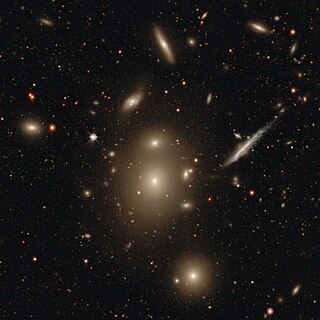
NGC 3842 is an elliptical galaxy in the constellation of Leo. It was discovered by William Herschel. It is notable for containing one of the largest black holes ever detected, reported to have a mass of 9.7 billion solar masses. It is around 330 million light-years distant from Earth.
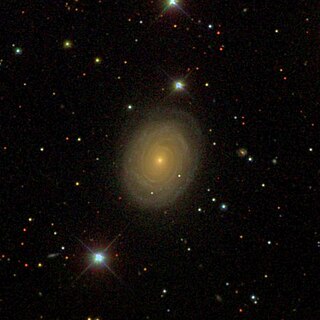
NGC 7001 is an intermediate spiral galaxy located about 300 million light-years away in the constellation Aquarius. NGC 7001 has an estimated diameter of 106,000 light-years. It was discovered by English astronomer John Herschel on July 21, 1827, and was also observed by Austrian astronomer Rudolf Spitaler on September 26, 1891.

NGC 7003 is a spiral galaxy around 220 million light-years from Earth in the constellation Delphinus. NGC 7003 has an estimated diameter of 80,800 light-years. The galaxy was discovered by German astronomer Heinrich Louis d'Arrest on August 26, 1864. There also has been at least one supernova observed in NGC 7003.

NGC 7250 is an irregular galaxy located in the Lacerta constellation. It is a blue-colored galaxy with bright bursts of star formation: its star-forming rate is more than an order of magnitude greater than that of the Milky Way.
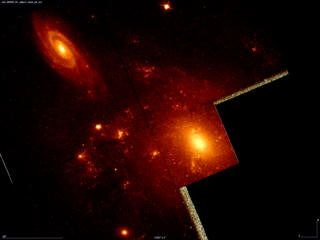
NGC 450 is a spiral galaxy located in the constellation Cetus. It was discovered in 1785 by William Herschel. NGC 450 has a very close companion, UGC 807, which is attached at the northeast side of the halo. UGC 807 appears fairly faint, fairly small, and elongated. Despite that UGC 807 appears to form a double system, the companion has a redshift that is over six times greater than NGC 450, so they are a line-of-sight pair.
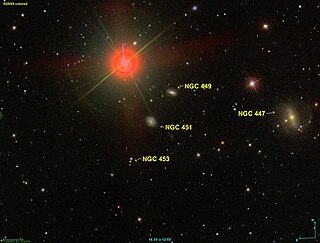
NGC 451 is a spiral galaxy located in the constellation Pisces. It was discovered in 1881 by Édouard Stephan.
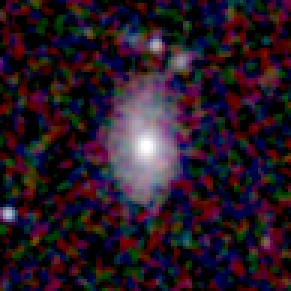
NGC 7301 is a barred spiral galaxy located around 308,000,000 light-years (94,000,000 pc) away from Earth in the constellation Aquarius. It was discovered by American astronomer Francis Preserved Leavenworth In 1886.
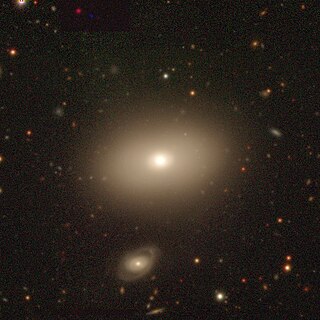
NGC 7302 is a lenticular galaxy located around 124 million light-years away from Earth in the constellation of Aquarius. NGC 7302 was discovered by British astronomer William Herschel on October 3, 1785 and was rediscovered by American astronomer Lewis Swift on August 8, 1896 and was listed in the IC catalogue as IC 5228. It is also part of a group of interacting galaxies.

NGC 463 is a lenticular galaxy located about 264 million light-years away from Earth in the constellation Pisces. It was discovered by French astronomer Édouard Stephan on December 16, 1871.
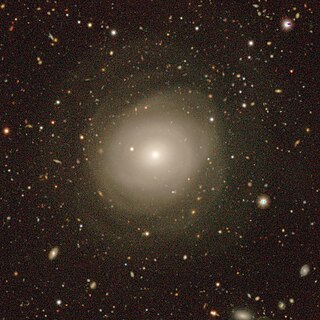
NGC 466 is a lenticular galaxy located about 227 million light-years away from Earth in the constellation Tucana. NGC 466 was discovered by astronomer John Herschel on October 3, 1836.

NGC 491 is a barred spiral galaxy located about 161 million light-years away from Earth, in the constellation Sculptor. NGC 491 was discovered by astronomer John Herschel on September 25, 1834.
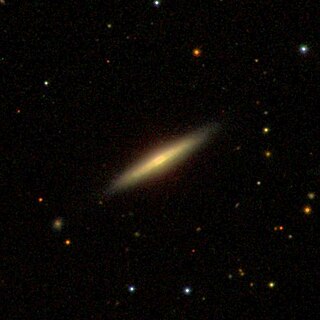
NGC 489 is probably an edge-on spiral galaxy located about 97 million Light-years away from Earth in the constellation Pisces. NGC 489's calculated velocity is 2507 km/s. NGC 489 was discovered by German astronomer Heinrich Louis d'Arrest on December 22, 1862.

NGC 487 is a barred spiral galaxy located about 250 million light-years away from Earth in the constellation Cetus. NGC 487's calculated velocity is 5949 km/s. NGC 487 was discovered by American astronomer Francis Leavenworth on November 28, 1885.

NGC 480 is a spiral galaxy located about 546 million light-years away from Earth in the constellation Cetus. NGC 480 was discovered by American astronomer Francis Leavenworth In 1886.

NGC 4473 is an elliptical galaxy located about 50 million light-years away in the constellation of Coma Berenices. It was discovered by astronomer William Herschel on April 8, 1784. NGC 4473 has an inclination of about 71°. NGC 4473 is a member of a chain of galaxies called Markarian's Chain which is part of the larger Virgo Cluster of galaxies.
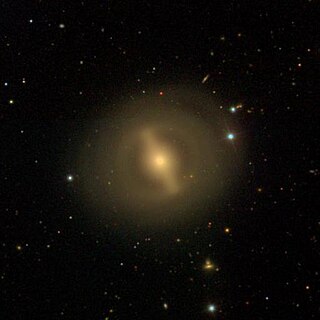
NGC 4608 is a barred lenticular galaxy located in the constellation of Virgo. The galaxy was discovered by astronomer William Herschel on March 15, 1784. At about 56 million light-years away, it is a member of the Virgo Cluster.

NGC 4753 is a lenticular galaxy located about 60 million light-years away in the constellation of Virgo. NGC 4753 was discovered by astronomer William Herschel on February 22, 1784. It is notable for having distinct dust lanes that surround its nucleus. It is a member of the NGC 4753 Group of galaxies, which is a member of the Virgo II Groups, a series of galaxies and galaxy clusters strung out from the southern edge of the Virgo Supercluster.

NGC 4478 is an elliptical galaxy located about 50 million light-years away in the constellation Virgo. NGC 4478 was discovered by astronomer William Herschel on April 12, 1784. NGC 4478 is a member of the Virgo Cluster.





















